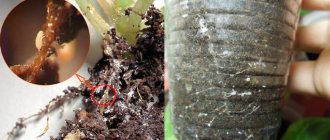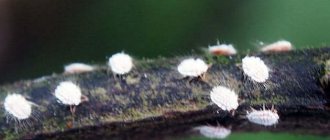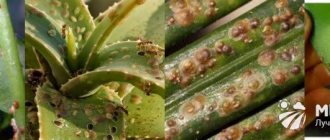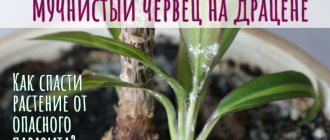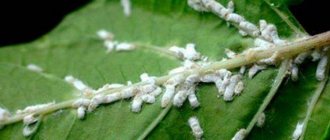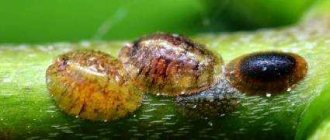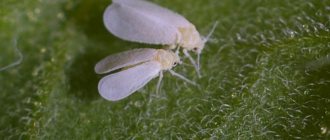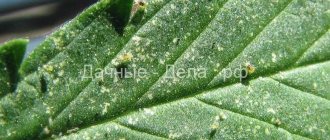Who are worms?
The scale insect is a pest that feeds on plant sap and is a relative of scale insects. Insects are covered with a protective waxy coating and villi (clearly visible in the photo), which makes it difficult to control them.
Body length ranges from 3 to 12 mm, depending on the species. Males are much smaller than females, have wings, and resemble small white midges. Due to the lack of oral apparatus, they do not need food, and their lifespan is not long.
Females usually live in colonies, on different parts of the plant; They are characterized by an asexual method of reproduction - parthenogenesis.
Description and types
Mealybug is a pest insect from the Hemiptera family. Distributed everywhere. In a warm apartment or nursery it reproduces all year round. Females of some species are capable of laying up to 2 thousand eggs during their lifetime, so new generations of pests appear and spread to neighboring plants very quickly.
The body of the mealybug is elongated, round in shape, convex on the dorsal side. All species have outgrowths on the body in the form of tubercles, spines, threads, covered with a white waxy coating reminiscent of flour. This is where the name comes from.
On a note! Another name for parasites is felt louses; the parasite is popularly called “shaggy louse.”
The mouthparts are adapted for parasitism: insects attach to shoots or roots, feed on plant sap, sucking it out.
Males and females are different from each other. Females of some species live up to six months, on average up to 2 months. Males do not have a mouth, their size is 1.5-2 times smaller than that of females. Having reached sexual maturity, they live for several days, their only task is to leave offspring.
The larvae, emerging from the eggs, quickly crawl and attach themselves to the soft parts of the plant.
The most common types are:
Bristlebug
The size of the female pest reaches 3.5 mm. The body color under the powdery coating is orange, reddish. Along the edges of the body there are numerous outgrowths in the form of bristles; in the caudal region there are 2 long thin filaments. Viviparous - egg development occurs inside the body.
Colonies develop on the underside of leaves, on the tops of young shoots.
Grape bug
The body is wide, the spines are small. The color of the cover is yellow, pinkish. There are few males in the population.
They most often settle on the underside of the leaf along the veins.
Grape
Primorsky mealybug
The insect will grow up to 4 mm in length. The color is dark pink, brown, brick.
The most numerous species of felt insects.
On a note! Other types of mealybugs can also be found on house plants: greenhouse, citrus, bamboo, cactus and others. Regardless of the type, pests cause great damage to the plant.
How do worms harm plants?
Insects cause great harm, leading pets to death. They prefer plants with large leaves, such as palm trees, ficus, orchids, laurel, and ferns. They settle on the reverse side of the leaf, in the area of large veins and stems.
- Mealybugs on indoor flowers suck out the juice, weakening them. Some species attack the roots.
- During their life, they secrete a sweet, sticky secretion that attracts ants and also contributes to sooty fungus and mold.
- Saliva contains phytotoxic enzymes that cause plant poisoning.
What plants does he like?
Citrus plants are attractive to mealybugs. In addition, he will not pass by:
- bromeliads;
- cycads;
- cacti;
- adiantum;
- godsons;
- ferns;
- monster;
- ardisium;
- brunfelsia;
- Dieffenbachia;
- shefflers;
- poinsettias;
- violets;
- fatsia;
- rhododendron;
- Cyperus;
- cissus;
- hippeastrum;
- orchids;
Attach the blaster to the hose and turn on the water. This environmentally friendly method of pest control is very effective as it provides enough pressure to damage and kill soft insects such as flour patties without harming the plants. After use, disconnect the blaster from the hose, then begin removing mealybugs that have landed on your soil. Don't risk reappearing on your plants if some are resistant enough to survive.
Learn an easy way to get rid of them that is safe for succulents! If you grow succulents indoors, you'll likely encounter powdery mildew at some point. They spread quickly from plant to plant and can be difficult to get rid of.
Developmental cycle of mealybugs
- Egg. Females lay eggs in a felt cocoon. Some species are viviparous - producing live larvae.
- The larvae move quickly, conquering new spaces; they are called “vagrants”. In some species, they are inactive. There is no gender distribution.
- Imago. After molting, strays become adults, females and males.
Signs of insect damage to indoor plants
At the initial stage of the disease, insects are difficult to detect, as they hide in the axils of the leaves.
Felt coating
A white coating appears on the stems and leaves of flowers, resembling cotton wool sprinkled with flour. These are cobwebs and wax dust secreted by females.
Sticky leaves
In the process of life, a sweet secret is released - honeydew, which is attractive to ants and moldy fungi. Leaves sticky marks on the pot, windowsill, window glass.
White lumps on roots
This sign can only be detected during transplantation. White lumps will be visible among the roots and soil. They can be confused with root aphids.
drooping look
A drooping appearance of the plant may be the only symptom of rootworm infestation.
Proper plant treatment
Housewives need to be especially vigilant in the fall and spring, when infection intensifies. The appearance of the parasite largely depends on temperature. The most optimal for reproduction and life activity is +25°C. That is why on warm days you should take extra care of the health of your plants.
It must be remembered that most often pests appear on weakened, devoid of strength leaves that are unable to resist the disease. Treated and well-groomed representatives have a natural defense mechanism that repels parasites.
By maintaining nitrogen levels by treating your plants with insecticides, you reduce the likelihood of your greens becoming infected.
If you notice a damaged area of a leaf or flower, you need to remove it. If the leaf or shoot cannot be removed, then try to remove as much plaque as possible with a toothbrush dipped in a soapy solution. You can use cotton swabs and any other devices that can gently remove insects. After the procedure, the plant should be washed. This will reduce the chance that the parasite will crawl onto a neighboring leaf. Immediately isolate infected greens from others.
If the algorithm of actions carried out could not help, you can proceed to more radical measures that require special caution. Namely, remove the top layer of the substrate inhabited by insects. This must be done so as not to catch or damage the root system.
Some varieties of mealybug attack the soil rather than the outside of the plant. The plantings begin to deteriorate before our eyes, wither and dry out. In this case, it is necessary to quickly transplant the flower to another soil. After removing the root system, you need to rinse it thoroughly, freeing it from any remaining parasites.
Areas that cannot be rid of insects should be carefully trimmed and only then replanted in new, fresh soil. The pot should be filled with clean substrate, and the root should be treated with an insecticide to further prevent the appearance of the parasite.
How to deal with mealybugs
Treatment must be carried out comprehensively, using several methods. Good results are obtained with chemicals in combination with a mechanical method of removing insects.
Mechanical method
With this method, pests are removed by mechanical means:
- Cutting out severely affected leaves and branches.
- Wash off insects with soapy water, using a sponge or soft brush.
- Nearby surfaces should be thoroughly washed: window sills, shelves, window frames, flowerpots - they can be a source of microscopic larvae.
Chemical
Insecticides that have an intestinal and systemic mode of action are used against mealybugs. Due to the fact that insects are covered with a protective waxy coating, contact exposure has no effect.
Due to toxicity, it is advisable to use chemicals in cases of extreme necessity, if home remedies are problematic to use or do not help.
- "Aktara" has an intestinal-contact, systemic spectrum of action. It affects the pest by direct contact with it, with simultaneous penetration inside through the oral apparatus. When applied to the soil, it is well absorbed by the roots, making plant juices toxic to parasites.
- "Aktelik" has a wide spectrum of action, systemic and contact. Treatment is carried out by spraying.
- “Bi-58 new”, systemic-contact mode of action. Affects any stage of insect development. The substance is quickly absorbed by the plant, the death of pests occurs within 24 hours. Highly effective against insects that parasitize roots.
- “Golden Spark” – works systemically, has a long-lasting effect, up to 2 months.
Important: treatment with pesticides is carried out using personal protective equipment.
Biological insecticides
Biological preparations such as Fitoverm do not have a systemic effect, therefore they are not effective against scale insects.
What to do: methods of struggle
The fight against mealybugs involves two stages: cleansing and chemical treatment.
Cleansing. What to do:
- Clean the leaves of the plant from cotton wool.
- They do this with a soap solution, wiping the green parts and shoots with a soft brush.
- Plants that can be irrigated are washed in the shower.
- It is important to replace at least the top portion of the soil.
- Severely damaged branches and shoots are cut off.
Chemicals. Necessary for extensive infestations and complement “mechanical” destruction. The most effective insecticides in the fight against mealybugs are insecticides and acaricides.
- Larvicides are drugs that only affect larvae.
- Ovicides are agents that affect egg laying.
- Repellents are deterrents.
Important! The most effective remedies are against both imago (adult insects) and larvae and eggs.
What to do, what means to use? Complex ones are best. And - depending on the degree of damage to plants. It is important to consider the appropriateness of use, comparing the toxicity of the drug and the damage caused by the insect.
- Treatments are carried out in open space. It is advisable to leave the pots outside, on the balcony for a couple of days.
- The event is repeated according to the instructions to get rid of all generations of the malware.
Let us remind you: all drugs can be divided into means of contact, intestinal, and complex effects. What does it mean?
- To reveal the effect of the former (contact action), the drug must come directly onto the insect or be in close proximity to it. This is a group of pyrethrins, pyrethroids, phosphorus, sulfur, and chlorine compounds.
- Intestinal agents - the active substance must be eaten by an insect, and blocks the central nervous system, gastrointestinal tract, etc., having a nerve-paralytic, toxic effect. Most often these are magnesium, barium, calcium arsenates (arsenic compounds), fluorides, metal fluorides, substances irgan, mitin, etc.
- Systemic - penetrate into plant tissues, then, when absorbed during feeding, along with tissue juice, poison insects. These are phosphamides, neonicotinoids, methylmercamptophos, etc.
- Complex - combines all qualities.
Chemicals: modern drugs
- Aktara from mealybug. Enteric contact agent, main d.v. Thiamethoxicam. Manufacturer Sengenta, Switzerland. Release form: suspension, concentrate, granules.
- Actellik. FOS compound (emulsion), enteric contact action, d.v. pirimiphos-methyl. Manufacturer Sengenta.
- Calypso. Bayer (Germany), enteric contact, systemic action, d.v. thiacloprid, concentrated suspension.
- Confidor. Bayer (Germany), d.v. imidacloprid, enteric and systemic drug for combating mealybugs, water-soluble concentrate in ampoules, canisters.
- Tanrek. Russia, CJSC "August". Systemic remedy against insects of contact action, d.v. imidaclopromide. Water-soluble concentrate in ampoules, canisters, bottles.
- Bankol. Enteric contact agent, d.v. bensultap. Tablets, yellowish powder. Manufacturer Sumitomo Chemical Co, Japan.
- Mospilan. Systemic remedy for scale insects and the widest group of insects with enteric contact action, d.v. acatamiprid. Manufacturer Nippon Soda, Japan.
- Phytofarm. Biological enteric-contact insectoacaricide, d.v. aversectin. Emulsion concentrate in ampoules, canisters. Produced by Pharmbiomed, Russia.
- Biotlin. Systemic drug, including imidaclopromide. Russia, CJSC "August". Release form: liquid in bottles, ampoules.
- Intra-vir. Enteric-contact insecticide against scale insects on flowers based on cypermethrin. Produced in Russia (Fasco) - tablets, water-soluble powder.
To get rid of mealybugs on indoor plants, Iskra Zolotaya or Double Effect, Vertimek, Bitoxibacillin, Dantop and others are also used.
For control of succulents and cacti, insecticides Decis, Karbofos, Actellik, Fufanon, Sherpa, etc., and any imadoclopramide-based products are good.
For example: how to get rid of mealybugs on plants and with what.
- Confidor: 5 l of water + 2 ml of product - spraying, for watering 2.5 l of water + 2 ml of product;
- Aktara for mealybug: 5 liters of water + 4 g of product (watering, spraying);
- Tanrek: for watering 5 l of water + 3 g of product, for spraying 1.5 g of product + 5 l of water;
- Apaches: 2.5 l of water + 0.5 g (package) – spraying, watering with 2.5 l of water + 2 ml of the drug.
Important! Cacti and succulents need not only to be sprayed, but also to lubricate relatively hard-to-reach places with a cotton swab.
But active wetting of these indoor plants is harmful - just like a shower!
Very important. To get rid of mealybugs for sure and quickly, treatment is carried out before oviposition - until the beginning of May.
Home Remedies
Effective in small distributions, when detecting single individuals. This is treatment with a soap solution followed by treatment with calendula infusion and tobacco infusion.
Infusion of onion peel. A brown infusion is prepared (onion skins are boiled and infused), the cooled liquid is sprayed on the plants repeatedly, and the light brown solution is poured onto the soil.
Horsetail Pharmaceutical tincture diluted 1:3, 1:5 repels the pest.
Alcohol + soap (for plants with leathery leaves). How to prepare: 1 liter of water + 20 g of soap + 20 ml of alcohol.
Garlic, onion. Essentially attractants: the infusion repels insects. How to prepare: chopped head of garlic (onion) + 1 liter of boiling water, boil for 2-5 minutes. Leave for 12-20 hours, filter, spray on plants and flowers.
Tincture of calendula. For 1 liter of water – 100 g of dried flowers, boil, then leave for a day. Wipe the leaves; if they are leathery or dense, lightly spray them.
How to get rid of mealybugs without using chemicals
Chemicals are far from safe, especially when used in an apartment. Immediately after detecting a pest, you can use folk remedies.
Green soap
Environmentally friendly product. Soap foam is applied to open, visible areas. After 2 – 3 hours, after treatment, it should be washed off.
Tobacco infusion
- Shag, raw materials or tobacco dust, in the amount of 80 grams, pour 1 liter of warm water, leave for a day.
- Then the resulting infusion is filtered and brought to its original volume.
- Treatment is carried out by spraying or washing.
Prevention measures
Mealybugs are quite difficult to exterminate, severely depleting plants. Therefore, it is much more effective to prevent their occurrence.
- Compliance with the rules of care is the most important preventive measure, since pests, as a rule, attack weakened plants.
- Regular examination of “pets” will help to recognize infection at an early stage.
- Before you bring a new plant into your home, you need to inspect it carefully.
- Quarantine for newly acquired pets is at least 30 days.
- Soil disinfection.
- Thorough disinfection of pots after diseased flowers.
In order to fight a pest, you should know its preferences and biological characteristics. Eliminating conditions favorable for parasites is the main task of preventing infection.
Reasons for appearance
A dangerous parasite enters a home with contaminated soil or seedlings on which scale insects have settled. It is possible for a pest to enter an apartment with a new flower purchased in a store or from hand. A careful inspection may reveal a tiny pest, dirty waxy "cotton wool" and larvae. It is no coincidence that flower growers advise carefully inspecting the plant in a flower shop so as not to accidentally introduce a dangerous parasite that is difficult to get rid of.
READ ALSO: Products for stable and continuous power supply
